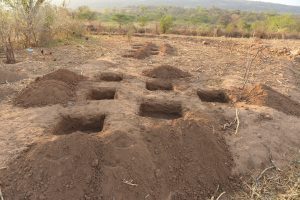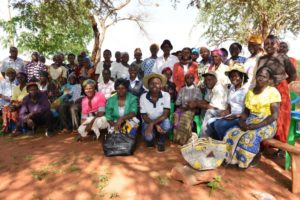
A simple farming technique is proving effective in staving off food shortages in Kenya.
The female farmers of Makueni County in southeastern Kenya rarely expect to triumph over their parched, unpropitious soils. A pick, a spade and a jovial, no-nonsense will-to-survive scarcely seem sufficient for a transition to greener prospects. In addition, the need for cash frequently robs these hardy women of men’s presence; casual labor in economic hotspots, or other work in livestock and poultry trading, is the norm.
Producing food thus rests on the shoulders of the women, many of whom are subsistence farmers or smallholders burdened with increasingly unproductive land. Severe land degradation coupled with drastic changes in climate has meant that many frequently face food shortages.
A flash appeal made by the government of Kenya and humanitarian organizations in July 2017 estimated that in the Kenyan drylands the number of people experiencing crisis levels of food insecurity owing to drought would increase from 2.6 million to 3.5 million by August of that year. Interventions are in abundance but few create an impetus to survive past a project cycle.
In her village of Mutembuku, farmer Veronicah Ngau has been working with government, development and research partners since 2005.
“Technologies like terracing and sunken-bed kitchen gardens have helped us cope but it was only in 2016 that I started to see a big change in what the land can produce,” she said. “In two planting seasons, I went from a usual 50 to 90 kilogram maize harvest from two acres of land to 270 kilograms from only one acre.”
This dramatic difference was achieved by nothing other than simple planting basins, which are a water-conservation technology that is improving food supply in the area.
However, social, environmental, technical and many other contexts differ from farmer to farmer and village to village, making it difficult to promote blanket adoption of the basins.

As part of a project funded by the European Union and the International Fund for Agricultural Development on restoring land for food security, which complements the Netherlands-funded Drylands Development Programme, the planting basins, which are also known as zai pits by the Western African farmers who innovated them, are being modified and tested, not just across villages, but also in several countries across the continent.
The World Agroforestry Centre (ICRAF), together with development and government partners, is leading the research component, or ‘testing for fit’, as an element of a larger drive to restore land.
“Thousands of farmers in Kenya, Ethiopia, Mali and Niger are now in the process of comparing options for soil and water conservation, tree establishment, post-harvest pest and disease control, livestock governance and farmer-managed natural regeneration,” said the CGIAR Research Program on Forests, Trees and Agroforestry’s (FTA) Fergus Sinclair, who leads ICRAF’s research theme on resilient livelihood systems and is the project’s principal investigator.
“We base this on a combination of systematic analysis of past successes and failures, local knowledge and participatory planning with farmers, extension workers and private-sector actors. It is not the basins in and of themselves we are interested in; what we are doing is looking for, and testing, options that are fit for their contexts while being relatively easy and low cost for farmers.”
Digging a pit is difficult work, perhaps more so than ploughing, but it has the advantage of being accessible to all and requires little more than a pick and a spade. Renting plough bulls operated by young, able men is not an easy option for many cash-strapped farmers in the area.
Ngau gave up on traditional tilling after three consecutive failed rains yielded stunted crops that were barely 30 centimeters high.
“Farming is a little bit like gambling here,” explained Joseph Ochola, a monitoring and data-collecting member of the project, who is local to the area.
“During droughts, the government will help us with 45 kilograms of maize per household per month; otherwise we have to buy what we need,” confirmed Ngau.

However, a 90 kg bag, cautiously consumed, costs KHS 2500 ($US25), which she says is a big chunk out of the KHS 6000 monthly earnings her husband makes as a casual laborer in town.
“When I started with 200 basins in a corner of my farm,” she said, “the idea was to compare the maize yields with our normal practice of farming. But in 2016, when we all lost our entire crops except those in the basins, I decided to switch and make more for myself; more than the project needed.”
A group of 10 women from her community of practice took up collectively digging three pits a week at each other’s homes. This gave them 30 basins a week but Ngau would also come home and dig three of her own each week.
“I have now covered half of my 2 acres with basins. Last season in 2017, during yet another drought, many of us with the basins were able to feed our neighbors who were not part of the project. They came to get some ears of maize every day. We were all able to eat. And even at harvesting period, I still got 270 kilograms, which also kept us going until the following planting season. I didn’t need the government handout anymore. Now others come to us to teach them how to do their basins.”
Scientists are now looking at the large data set involving thousands of farmers to explain when the basins are practical options and when they are not.
“This is only our third planting season and we are still in the process of collecting the data for all the different options related to the basins,” said Leigh Winowiecki, a soil scientist at ICRAF who manages the project. “But even in the comparisons, some areas have already been more than tripling the maize yields. Of course, it will not work the same for everybody.”
“Without this information, we cannot simply go and advise development partners to promote them,” explained Sinclair. “It will be a waste of their time and the farmer’s time to scale something that has not been tested and proven to work in the areas under question.”
By Akefety Mamo, originally published at ICRAF’s Agroforestry World.
The project ‘ Restoration of degraded land for food security and poverty reduction in East Africa and the Sahel: taking successes in land restoration to scale’ is funded by the International Fund for Agricultural Development (IFAD), and the European Union (EU).
This research is part of the CGIAR Research Program on Forests, Trees and Agroforestry (FTA), which is supported by CGIAR Fund Donors.











